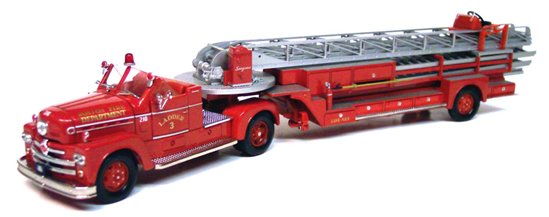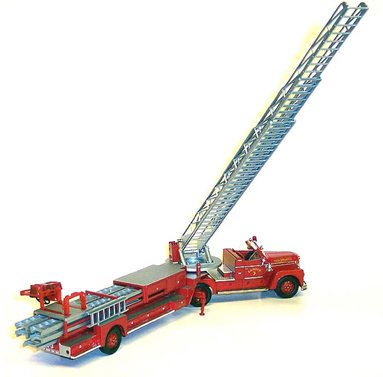|


Corgi continues its “Heroes Under
Fire” series with a new 1:50 Seagrave 70th Anniversary series
tiller, patterned after Boston’s Ladder 3. This model shows a steady
improvement from Corgi in detail, accuracy, and overall quality. I
for one am pleased to see Corgi continuing this product line,
because I believe they offer an unbeatable value for the collector
of vintage Fire Apparatus.
This model is a beautiful addition for those collectors who crave
“classic” Fire Apparatus. Corgi has revamped its packaging, and the
model is securely mounted inside of an acetate dome for those who
prefer displaying their trucks “in the dome”. For those who would
rather display it in the open, the model is easily removed. No tools
or muscular fingers are required; several wire twist-ties are all
that secure it inside. The model and dome are inserted in an open
ended shipping sleeve, with graphics on all sides. And don’t be
fooled by the pictures on Corgi’s website, the model I’m looking at
is much more refined than the ones shown. There is also a card
inside the package, with an invitation to any Firefighters of
Letters, past and present, who might like to share their experiences
on any of the various apparatus types that Corgi reproduces.

Seasoned Corgi collectors should
not be surprised when they discover that the side view mirror and
lamps (one on each side) are not attached. The mirrors are molded
onto a separate parts tree inside the package, and you must cut them
loose and mount them yourself. This doesn’t require any great skill,
but it is a minor repeat annoyance. Tip: a tiny dab of gel-type
super glue, carefully placed in the mounting holes, is sufficient to
secure the mirrors in place.

I couldn’t help comparing this
model to the similar Baltimore tiller that Corgi released last year.
A common problem with that truck was the issue with the windshield
mounted gumball beacon. It wasn’t straight, and many collectors
inadvertently snapped it off while trying to correct it. Happily,
Corgi’s quality control seems to have eliminated that problem. The
front fenders also have beacons mounted on them, something that the
Baltimore lacks, but there is no hand brake behind the driver’s
door. I assume it was inside the cab on the real truck. I believe
there should be handrails down both sides of the trailer, but these
are absent. There are extinguishers and a pike mounted on the
trailer as separate parts, and these add nice detail features. The
cab interior captures most of the few details that would have been
present on the real truck: simple vinyl upholstery, gear shift,
radio, or possibly a PA system, and hand brake. There is even
something that looks like a glove box. I wonder if the Lou kept a
flask in there?
While I quite enjoy the Baltimore ladder, it
seems Corgi has moved a few steps ahead with quality control. In my
collection, I have the earlier Corgi Mack CF tiller for Long Beach,
and the ALF closed cab tiller for Centerville. Those were made when
Corgi was crossing over from toys to the collectibles market, and
are no comparison to the latest offerings. Both will surrender their
shelf space to the new Seagraves. The restrained tampo graphics are
accurate, and along with the truck itself are what you should expect
from a big city Fire Department of the fifties and sixties: simple
and functional. There isn’t an abundance of gold leaf or scroll
work, nor should there be. Reflective striping was far into the
future. The model conveys the sense of representing a tough,
hard-working, and financially restricted Department (aren’t they
all?) of the past. Taxpayer dollars were not expended on extravagant
creature-features, like a heated cab, or even a roof. Remember the
hand rails? Most of the guys didn’t even have seats! Ladder 3 was
not a parade rig, and that’s one thing I like about it. This truck
was a worker.

While doing a bit of research on
the Boston Fire Department, I came across a riveting account of the
Paramount Hotel Fire of 1966, by Boston Firefighter and historian
William Noonan:
http://www.cityofboston.gov/bfd/journal/paramount_hotel_fire.htm

This fire is not only remembered
for its terrible destruction and loss of life, but for the extremely
frigid, windy, and icy conditions that faced the Boston Jakes. Our
Ladder 3 was there, in all of its roofless and unheated glory.
Glancing at this model, I can’t begin to imagine what it must have
been like to respond in the middle of the night, in subzero
conditions and high winds, wearing a rubber turnout coat and leather
helmet, but still soaked and chilled to the bone with no warm and
dry cab for a temporary retreat.
Dennis Smith recounts in “Report
Form Engine Co. 82” how, when fighting such fires in the South
Bronx, they would rouse a local building superintendent and have him
open the boiler room so the guys could take a blow. FDNY Ladder 31
would have been an open cab American LaFrance tiller during this
same period.

In
the century or so leading up to those events, there were perhaps
fewer innovations in how fires were fought or in the science of fire
itself than there has been in the few decades since. The Fire
Service and the technology behind it has changed somewhat, even if
it just acknowledges that Firefighters are only flesh and blood, and
provides for them accordingly. At least, it tries to. Only forty or
fifty years ago, this was far less evident.
Corgi does a nice job of controlling the chrome on their models, and
this one is no exception. The main aerial, removable ground ladders,
and most of the diamond plate surfaces are properly done in a matte
aluminum finish. Chrome doesn’t belong on any of these, and would
have ruined this nicely understated model. The metallic tone is
smooth and consistent throughout, without any swirl-marks. The
quality of the molded plastic parts is very good, with no injection
marks, sprue or flash. The running boards are chromed, which might
be somewhat inaccurate, but this doesn’t really detract from the
model at all. The paint finish is also first rate, it’s smooth and
glossy and has no runs or blemishes. The slam locks on all
compartments are part of the casting, and are neatly highlighted
with silver paint. There are no “stickers” on this model, and with
the current state of the art, there shouldn’t be. All of the diecast
parts have a tight and straight fit, with no play at all.
The assembly quality is excellent. The model sits straight and
level, and rolls smoothly. The trailer is detachable simply by
lifting it from the cab, so Use caution when picking the model up.
Both have fairly detailed undercarriages. The outriggers are very
detailed, and are fully functional. They are a bit stiff and care
must be taken when extending them. The tillerman’s seat flips up and
over to allow elevating the ladder. The plastic seat frame is molded
in color, but isn’t quite the same shade of red as the paint job.
The ladder traverses and has just enough tension to stay up
unassisted. It also extends smoothly. The model is almost exactly 12
inches long and 2.5 inches high at the rear windshield, its highest
point. The three-section ladder extends to 18.4 inches from the
turntable to the tip, which by my math means that this is actually a
75’ ladder. I’m not sure what the real truck had, but 75’ tillers
were common enough in that era.
Is the model perfect? Of course not. No model from any manufacturer
can be to every collector’s eyes, and there are a few items that I
personally would like to see, such as hand rails.
Overall, I am very pleased with the model, and I had no bad
surprises. In summary, Corgi has done an excellent job in recreating
this great piece of fire apparatus history. There is no comparable
value for these vintage trucks in this scale or price range, and
most collectors will find this to be a highlight of their
collection.
All photos are Copyrighted by Steve McGuire |